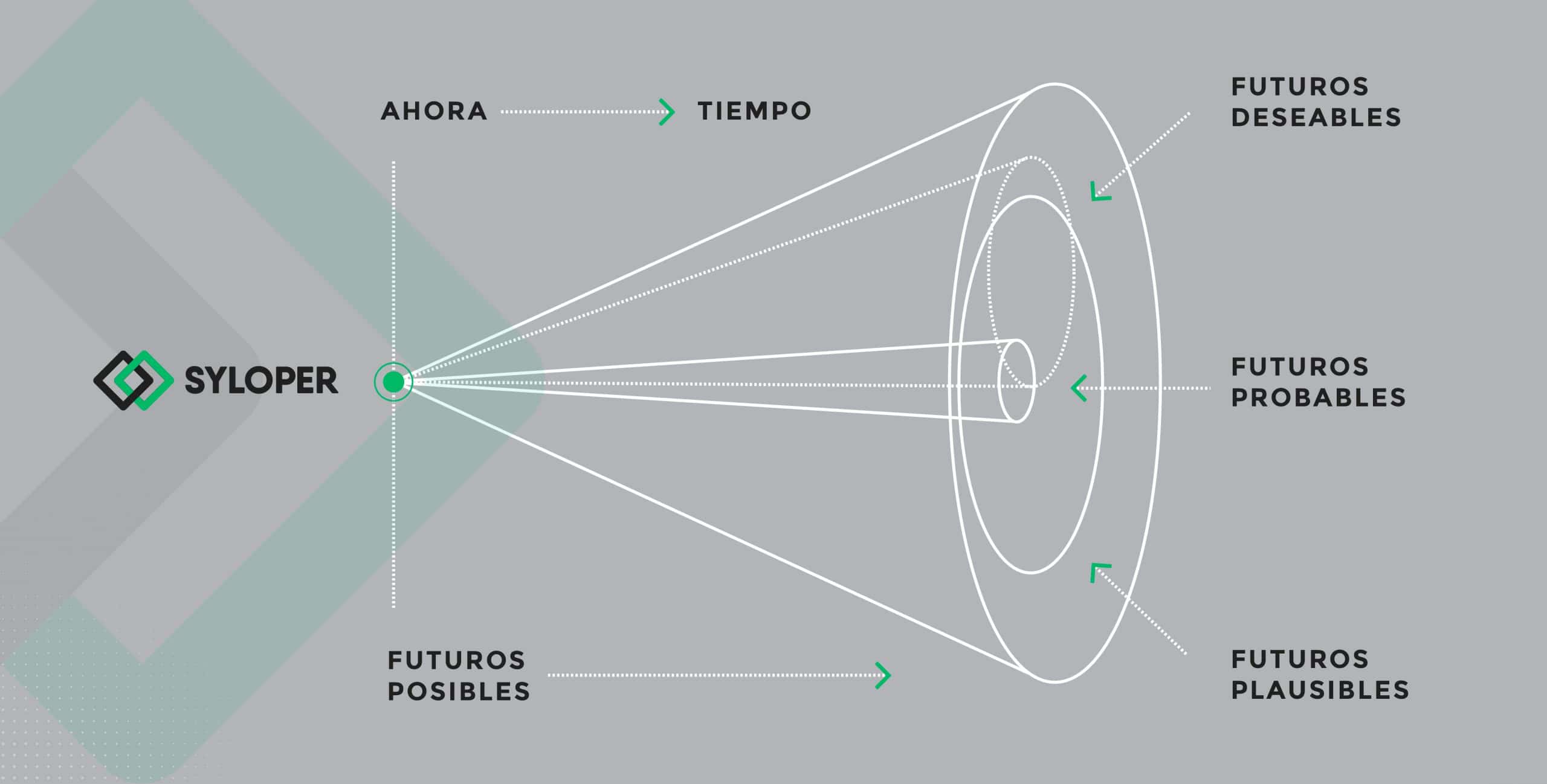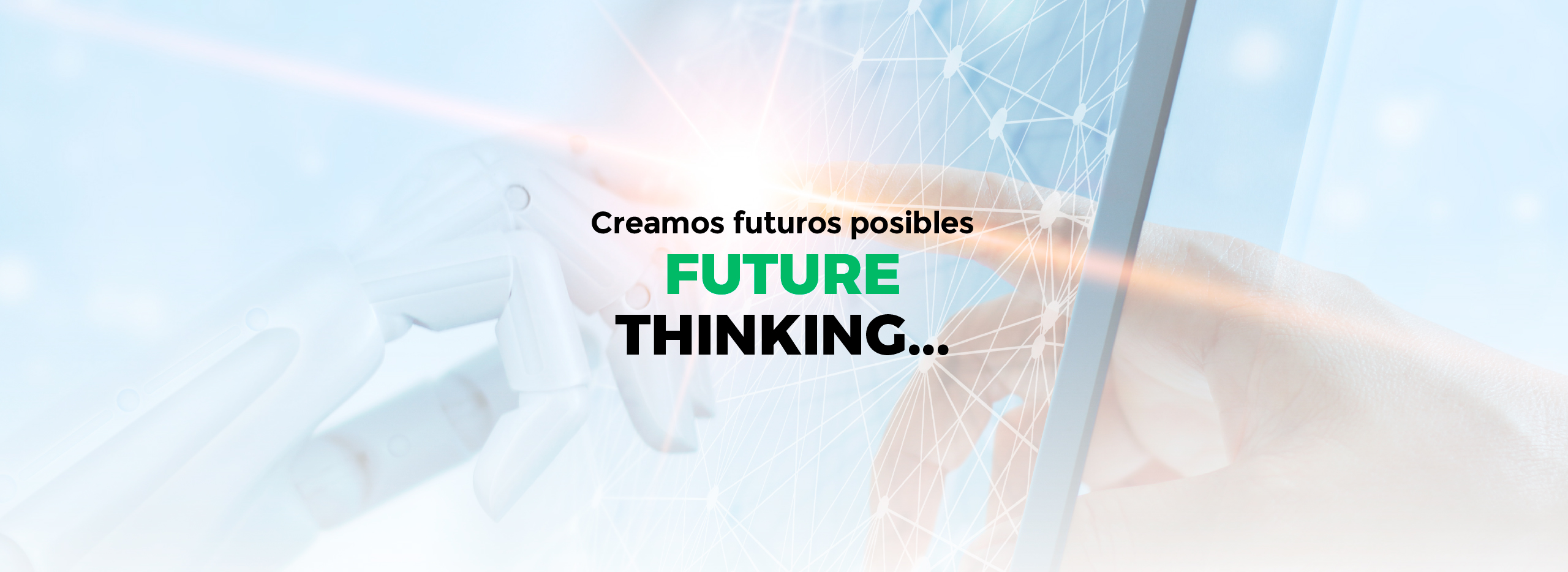We are going through a time of breakdown, in which changes are occurring permanently and disruptively. The future is uncertain and unpredictable.
Nowadays, societies do not have answers to the challenges we face. We try to solve the problems of the future with the tools of the past. There is a gap in which many companies struggle to adapt and transform to continue to exist and be competitive.
In this context, Future Thinking appears as a new way of thinking, a new tool at the service of people and organizations to increase the ability to visualize ourselves in future scenarios and to face the challenges that this new era imposes on us.
What is Future Thinking?
Future Thinking is a set of different methodologies and techniques that allow projecting possible future scenarios of a topic or area. It aims to detect the unexpected implications and challenges that we can address from the present to transform it.
It combines different techniques to collect data, identify trends, create strategies, and visualize potential future scenarios.
Future Thinking opens up a range of infinite alternatives and gives us the capacity to anticipate, which is a very important ability to face what is coming. Exploring possible futures will help us break paradigms and exercise our creativity, a fundamental tool to overcome adversity, survive, and reinvent ourselves.
Principles of Future Thinking
We base this method that explores the future configuration of organizations and societies on the following principles:
- The future is plural because there are many likely scenarios.
- The future is not immovable or linear; it combines alternative futures: possible, plausible, probable, and preferable.
- People choose the different alternatives of the future and act accordingly.
- The future is always open and in motion; it is not something fixed.
- We build the future, so the minor changes we make today can be extremely important tomorrow.
Future cones: exploring possible futures
From the perspective of Future Thinking, the future is no longer understood as a singular space, but as a plurality of scenarios. The cone of Voros or cone of futures illustrates this new paradigm.
It is a cone where the present is at the vertex. It represents time in projection and it widens as it moves away: every time we look or want to anticipate the future, the ignorance and uncertainty increase.

Inside this cone, there are many categories of the future.
1/ Probable futures
They are the futures that have some probability of happening from the statistical or social perspective. The knowledge and resources to make them viable already exist.
2/ Plausible futures
They are not as likely to occur as probable futures because of social, political or economic trends. However, the resources and knowledge to make them workable already exist. Therefore, faced with a change in forces or an unforeseen historical event, the probability factors could be altered and become a probable future.
3/ Possible futures
These futures include the probable and the plausible, and also other non-probable and implausible scenarios. They are those futures that, when thinking or imagining them, do not seem strange to us. We know little about them to happen, but we could quickly achieve it and sooner than expected.
4/ Preferable futures
These futures, whether probable, plausible or implausible, are desired by society, by a specific group or by companies or organizations.
It is important to consider all these futures and to be aware that we can vary from one to another depending on the energies and resources put in them. It may happen that a preferable future, considered possible, is probable and finally present.
The most important lesson that the future cone gives us is that there is no single scenario but that there are many and diverse, and we can all contribute to moving from a preferable future to a probable one. We do not have a single and inevitable path, but different paths are presented to us, with some uncertainty. If they are effective depends on different factors, including political, social and technological ones. Futures depend on all of us for them to become the present.
Benefits of Future Thinking
Future Thinking offers innumerable benefits, both individual and collective. It prepares you to be a better person, and it is a key tool for the improvement of organizations and society.
Some benefits are:
- It strengthens mental flexibility, which is increasingly important since this changing world forces us to continuously adapt and innovate.
- It helps to anticipate changes. The tools of this discipline allow a deeper understanding of the values of the clients and their constant changes. In this way, you provide a competitive advantage, as others may have difficulty detecting those changes.
- It allows identifying connections between different points to create better projections of future possibilities. Thus, it generates a broader and more innovative vision through which organizations can visualize the outlook and give more importance to the context in the Future Thinking of their business.
- It stimulates dialogue and invites us to question the present and imagine the future through an enriching exchange between collaborators. A more complex thought maintains this.
- It improves empathy. To build possible futures, it is necessary to understand how people think, feel, and act.
Future Thinking techniques
There are a wide variety of different techniques and tools to support Future Thinking. Some of the most used are:
✦ Scenarios
These are stories that describe alternative ways in which the outside environment could develop in the future. It seeks to create a frame of reference where we can intervene in different layers of organization that allow us to influence the future.
It is a tool for decision making that allows us to work with complexity, uncertainty, and volatility.
✦ Future mechanism
They illustrate things that could exist or occur, providing visibility into the forms that possible futures might take in the present.
✦ Backcasting
It works from a preferable future backwards to identify the actions necessary to shape those preferable futures.
✦ Horizon scanning
It is a structured process of looking for early signs of change, which could alter the topic you are working on in unexpected ways.
✦ People
It shows how possible futures could affect different people, and how people’s values and interests can influence different future alternatives.
These and all the techniques that Future Thinking uses are based on the analysis of current conditions, trends, events, and future facts. We rarely see those signs, but they allow us to anticipate and prepare for what is coming.
Its goal is to project what might happen in the future and communicate our daily choices about the one we want to achieve. In this way, they help to see and inform future possibilities and to work properly in the present to influence and change the future.
Future Thinking in action
Regarding business, the inside-out view has long dominated. Future Thinking invites us to change that perspective and observe and think from the outside in. We seek to open the gaze and mind to have a broader panorama and see beyond the place where our company or organization is located. It is a logic that moves away from what is happening now to get closer to what will happen and the benefits that we can get from it.
Future Thinking is a way of gaining new perspectives and contexts for current decisions. It teaches us we cannot predict the future, but we have to decide based on what is coming. It helps us see more clearly where we are going and creates alignment between teams and organizations.
At Syloper, we create solutions for a future that will be pierced by a constantly changing world. We cannot predict the future, but we have all the tools to think about it, analyze it, imagine it and use it to our advantage. We know that even when the unexpected happens, Future Thinking can guide us toward our clients and our preferable future.
And we use Future Thinking techniques because we believe that they have far-reaching implications, and they help us see each situation holistically. They enable us to think beyond what is possible and allow us to build a shared vision for the future. We are always thinking of providing added and concrete value to our clients and working in the face of the global challenges of today and tomorrow.
⋄⋄⋄⋄⋄
✚ Keep reading:
▶ Some recent projects:
- Aapresid Congres 2021: we accompanied the great event of agriculture trough technology
- Aapresid Events: tailor-made streaming platform
- La Segunda Recompensa: an effective landing page
- Vlov: support app for people with problematic consumption
❖ We are Syloper, a software development company based in Rosario, Argentina and with projection throughout Latin America and the entire world.
✉ If you need us to help you make your idea come true: contact us.
